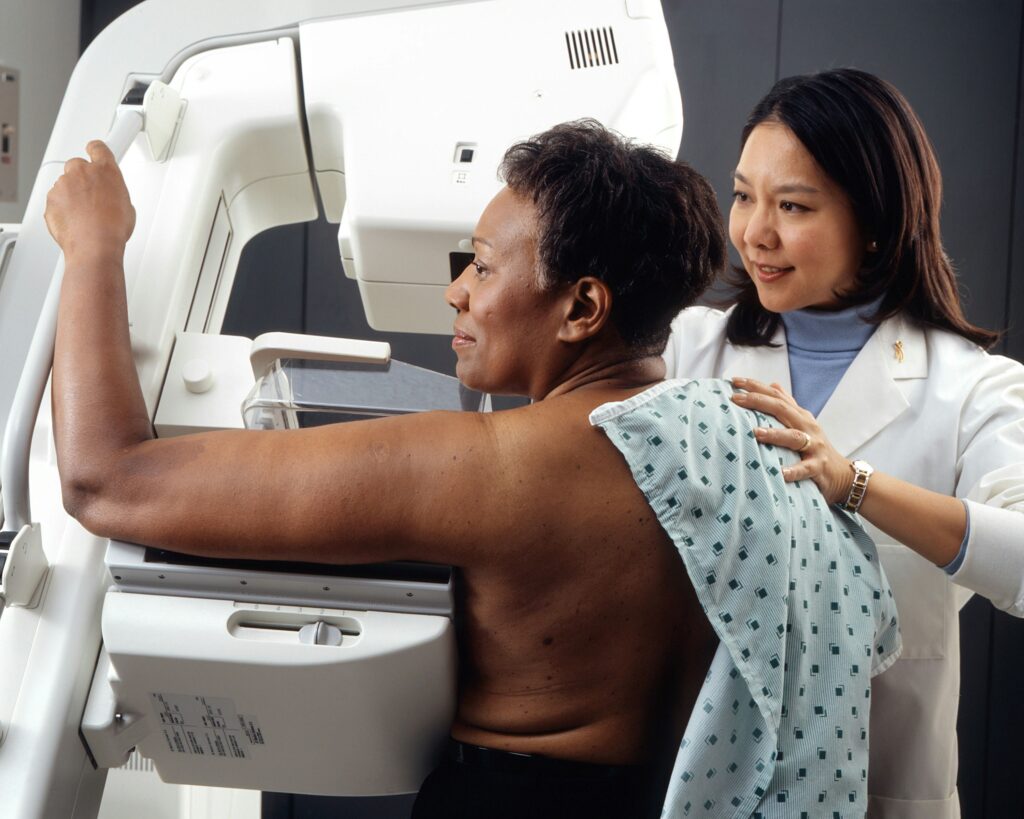Breast cancer is one of the most common types of cancer in the world. It happens when cells in the breast grow abnormally and form a lump or tumor. If not treated, these cancerous cells can spread to other parts of the body. While this condition mostly affects women, men can also get it. Additionally. although it’s most common in white women, it tends to be more aggressive in Black women. Here’s what you need to know about this disease, risks associated with it and what to do and expect if you’re diagnosed with breast cancer.
What It Is
Like all cancers, breast cancer begins when cells become damaged and begin to grow uncontrollably. Because it specifically targets breast cells, it is known as breast cancer. The overgrowth can sometimes begin in the milk ducts or even the lobules, or milk glands that produce milk. In some cases, the condition is localized just to the breast region, but for more aggressive forms, it can spread to other parts of the body. While most people think of it as a “woman’s disease”, it can develop in men too.

It can affect anyone, but some people are at a higher risk than others. Here are some of the main risk factors:
- Age: The risk increases with age. Most cases occur in women over 50, but younger people can also develop it.
- Ethnicity: White women are diagnosed with breast cancer more often than women of other races. However, Black women are more likely to have aggressive types, usually because diagnosis typically happens when it’s progressed to later stages.
- Family History: If a relative like a parent, sibling or grandparent had was previously diagnosed, the risk is higher of getting a cancer diagnosis. Some people inherit genes like BRCA1 and BRCA2, which increase the chance of getting breast cancer.
- Lifestyle Factors: Unhealthy habits can also raise risk. Factors like smoking, drinking alcohol, eating unhealthy foods, not exercising, and exposure to chemicals can contribute to the disease.
Clinical Pharmacist, Dr. Diana Rangaves, “Breast cancer risk may be mitigated with the use of medications, such as tamoxifen and raloxifene. The drugs are the only two drugs approved by the FDA in the United States to minimize the risk of breast cancer. A frank discussion with your healthcare provider is warranted before starting any regimen.”
What’s Happening in Your Body
There are several types, each with different risks and treatments:
- Inflammatory Breast Cancer (IBC): This is a rare but aggressive type of cancer that causes the breast to become red, swollen, and warm.
- Ductal Carcinoma In Situ (DCIS): This is a non-invasive cancer where abnormal cells are found in the milk ducts. It has a high survival rate if treated early.
- Invasive Ductal Carcinoma (IDC): IDC is the most common type. It starts in the milk ducts but spreads to other parts of the breast tissue.
- Triple-Negative Breast Cancer (TNBC): This type is more aggressive and harder to treat. It is more common in Black women and younger women.
Early detection is key to treating breast cancer. Here are some common warning signs:
- A lump in the breast or underarm.
- Changes in breast size or shape.
- Unexplained pain in the breast.
- Nipple discharge (other than breast milk) especially if it’s blood.
- Skin dimpling or redness.
If any of these occur, it’s important to see a doctor as soon as possible. One of the best ways to catch breast cancer early is through regular health checkups. A mammogram, which is an X-ray of the breast, is the most common test used. Women over 40 should have a mammogram every year or as recommended by their doctor. Early detection increases the chances of successful treatment.
Causes of Breast Cancer
To date, experts haven’t found evidence to point to one definitive cause for breast cancer. However, there are a variety of factors that can contribute to it.
- Family History: Having a relative who developed breast cancer and even carrying specific gene mutations like BRCA1 and BRCA2 can increase a person’s risk.
- Hormones: Sometimes having heightened levels of estrogen and progesterone for extended periods can increase the risk of breast cancer. Likewise, starting menstruation earlier or later than the average range, and even undergoing hormone replacement therapy (HRT) can increase the risk.
- Environmental Exposure: People who have had radiation therapy in the chest area or even were exposed to known carcinogenic chemicals may be more at risk of being diagnosed with breast cancer.
Health Risks and Complications
Black women are more likely to be diagnosed with aggressive types of breast cancer, such as triple-negative. Unfortunately, they are also more likely to be diagnosed at later stages, which makes the disease harder to treat. Some of the reasons for this include differences in healthcare access, less frequent screenings and less awareness about symptoms.

What To Do About Breast Cancer
A breast cancer diagnosis can be scary, but many people survive and recover. Here are some steps to take after being diagnosed:
- Speak with a doctor: Learn about the specific type you’re battling and explore treatment options.
- Consider options: Common treatments include surgery, chemotherapy, radiation and hormone therapy.
- Find support: Talking to family, friends or support groups can make coping easier.
- Stay positive: Many people go into remission, meaning the cancer is no longer detected in their body.
Breast cancer treatment can be challenging, but knowing what to expect can help:
- Surgery: Some people need an operation to remove the tumor or even the whole breast (mastectomy). However, reconstructive surgery is an option. In many cases, this depends on when the mastectomy performed, reconstruction can occur simultaneously.
- Chemotherapy: This involves strong medicine that kills cancer cells but may cause side effects like hair loss and nausea.
- Radiation Therapy: High-energy rays target and destroy cancer cells.
- Hormone Therapy: This treatment blocks hormones that help some types of breast cancer grow.
Recovery chances depend on the type of breast cancer, how early detection, and how well a person responds to treatment.
When to See a Doctor
Ideally, women ages 45 to 54 should be receiving annual mammograms. Women under 45 are encouraged to perform regular self-breast exams, and to seek medical attention if they discover a lump. Women 55 to 75 are recommended to receive a mammogram every two years or annually if preferred.
Even with at-home breast exams, if a lump is discovered, or it feels as if there are changes in the breast such as pain, or nipple discharge, it’s important to see a doctor. Early detection can significantly improve the odds of treating the cancer and having it go into remission.
Related Questions
How long do you live with breast cancer?
Survival rates are often dependent on the stage in which breast cancer was discovered. According to the American Cancer Society, the five-year relative survival rate is 91%. Stage 1 (localized) cancer has a survival rate of over 99% and stage 4 (significant spreading) has a rate of 32%. Other factors like treatment, the person’s age, and even the type of tumor will also influence outcomes.
How does breast cancer affect the body?
Left untreated, itcan impact more than the localized area. Fatigue, weight gain, and even the cancer spreading to other vital organs are all possible. Likewise, even treating cancer can create side effects such as localized pain from the surgery, fatigue, cognitive impairment, and pain.
What area early signs of breast cancer?
Common early signs beyond a lump or thickening in the breast or armpit area can include swelling, puckering, and dimpling of the breast skin. People might also notice changes in he size or shape of the breast and even the nipple might begin scaling, experiencing discharge, become discolored, or even experience inversion.
Bottom Line
While being diagnosed with breast cancer is a terrifying prospect, early detection is one of the most effective ways to ensure positive outcomes. Black women in particular often suffer higher mortality rates because of late detection when the cancer has become too far advanced to respond to even aggressive treatments. Prioritizing at-home breast exams and regular mammograms can help people take control of their health and be part of the 91% survival rate statistic.
Frequently Asked Questions
Why are Black women more likely to get triple-negative breast cancer?
Scientists are still studying this, but factors like genetics, environment and access to healthcare play a role. TNBC is more common in younger Black women and tends to grow and spread faster.
What is the life expectancy of a person with breast cancer?
Life expectancy depends on the stage of the cancer at diagnosis. If detected early, the five-year survival rate is about 99%. If it has spread to other parts of the body, the survival rate is lower but improving with better treatments.
What are the top three signs of breast cancer?
- A lump in the breast or underarm.
- Changes in breast shape or size.
- Unexplained nipple discharge or pain.
